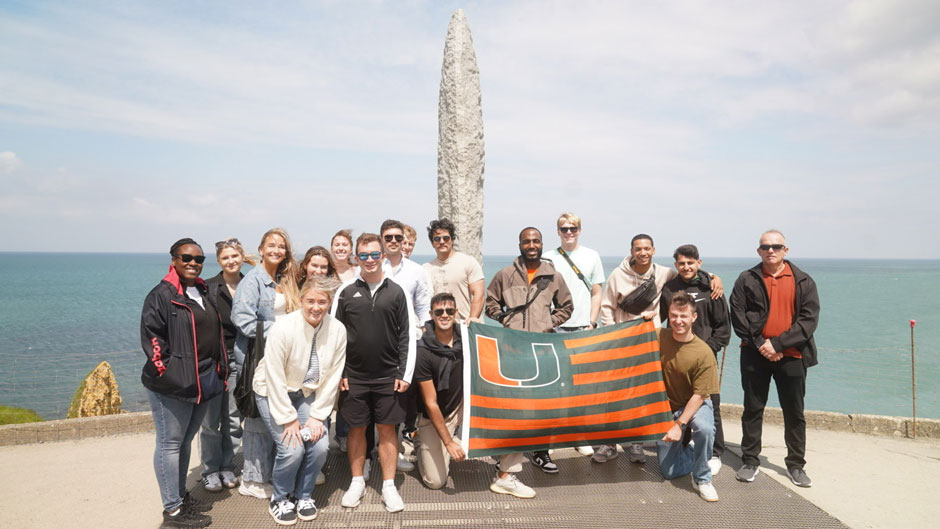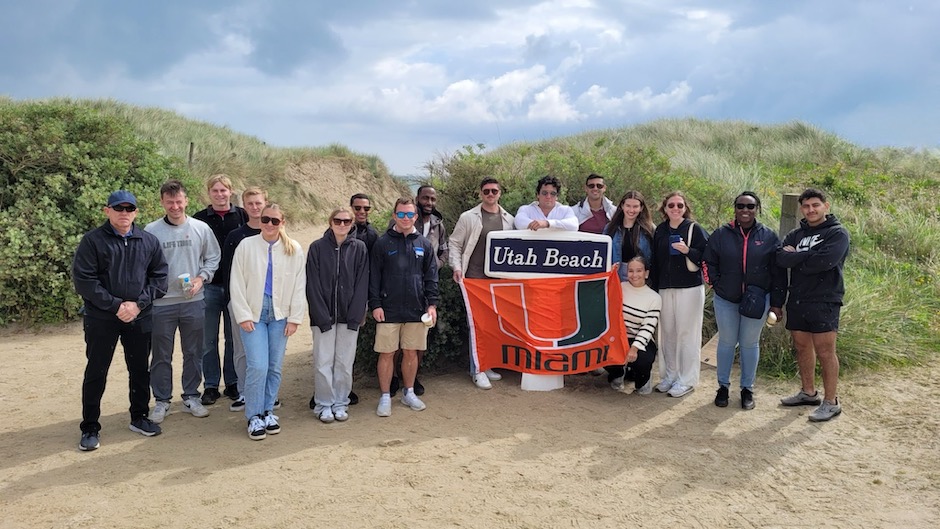It’s one thing to read about D-Day or see it depicted in movies and quite another to visit the beaches of Normandy where Allied troops landed in 1944 to liberate France from Nazi occupation.
That’s what 15 University of Miami Air Force and Army ROTC cadets discovered when they traveled to Normandy in late May, two weeks before the 80th anniversary of D-Day.
“It’s definitely a different experience learning about history in a classroom than it is going to the location where it took place and seeing how it happened,” said Cadet Nicholas Keeler, a rising senior majoring in aerospace engineering who went on the military studies trip.
The cadets first visited Omaha Beach, which saw some of the worst fighting on D-Day, before paying their respects to fallen soldiers at the nearby Normandy American Cemetery in Colleville-sur-Mer. More than 9,000 Allied soldiers were killed or wounded on D-Day, which marked a crucial turning point in World War II.
“Stepping on the very place where the most famous battles took place is breathtaking. The location is preserved so that you can not only understand history, you can walk the same paths, touch the same rocks, and see the exact location where the battle began and ended,” said Tech. Sgt. Jacquelyn Jones, who served as the Air Force ROTC chaperone on the trip. The University’s Air Force ROTC program is housed in the College of Arts and Sciences’ Department of Aerospace Studies.

University of Miami Air Force and Army ROTC cadets visiting a D-Day monument while on a trip to Normandy, France. Photo: University of Miami Air Force and Army ROTC
The cadets also visited Utah Beach, one of the other beaches where Allied troops landed on D-Day, as well as other historical sites and museums. The trip was sponsored by the ROTC Global Scholars Fund, which was established by Normandy veteran Ash Rothlein and his wife Liz.
Before traveling to France, Jones and Sgt. 1st Class Rodny Yefune, the other chaperone on the trip, asked each cadet to research a different place in Normandy. The cadets then presented their findings to the group when they visited that location.
“Not only were we there, but they had to tell us what happened,” Jones said.
For Cadet Alexander Nieto, a rising sophomore and international studies major, one aspect of D-Day history that stood out was just how much the Allied troops “had to improvise every step of the way.” With modern surveillance technology, he explained, the military can conduct more effective reconnaissance missions today than they could in the 1940s.
Nieto and Keeler said that while each day of the trip was meaningful, they were most impacted by the visit to Omaha Beach, where more than 2,400 U.S. troops were killed or wounded. The Nazis had lined the coast with land mines, concrete bunkers, and other obstacles, and they fired down on Allied troops from the cliffs overlooking the beach.
“Now it’s really beautiful, but you could see back then how the different bunkers were hectic to be near or try to get through,” Nieto said.
“It’s terrifying that the Allied forces had to land on these shores with little cover, where much of the German resistance was perched up on these massive hills and could rain mortar and artillery fire down below,” Keeler added.
For the cadets, the trip was a sobering reminder of the sacrifices U.S. troops made during World War II.
“Every part of the trip had a significant detail to it,” Nieto said. “It was very eye-opening.”

